Features
Shipwreck Alley
By SAMIR S. PATEL
Tuesday, December 16, 2014
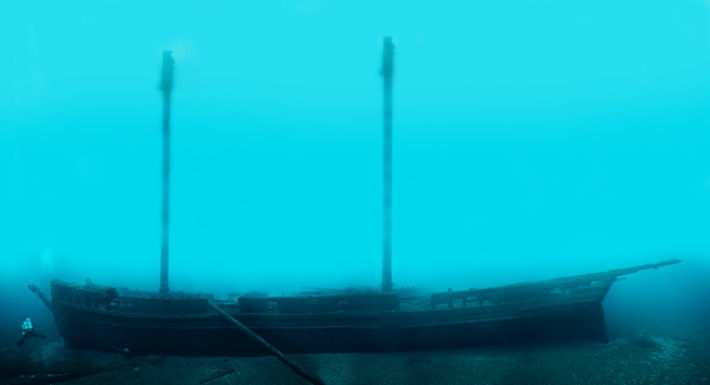
Three men are sitting on the aft deck of RV Storm, a 50-foot research vessel bobbing gently on Lake Huron on a clear, warm July morning. They’ve more or less disappeared under shrouds of black neoprene, masses of corrugated and smooth tubes, and constellations of metal tanks, clips, and fasteners. Dive safety officer Jason Nunn calls out a checklist that sounds arcane even to an experienced scuba diver:
“Press the ADV to ensure proper operation.”
“Confirm computers are set for CCR mode and that you’re on the appropriate mix.”
“Set your PO2 to 0.5.”
The divers—Russ Green, Joe Hoyt, and Tane Casserley—are underwater archaeologists with the Office of National Marine Sanctuaries of the National Oceanic and Atmospheric Administration (NOAA). They are wearing rebreather systems that scrub the carbon dioxide from their breath and recycle the air, allowing them to dive deeper and stay down longer than divers with traditional open-circuit scuba gear. In a few minutes, they will drop 165 feet through the clear, cold water to the wreck of Pewabic, a 200-foot-long freighter that sank in 1865 after a mysterious collision. Pewabic is one of hundreds of wrecks and suspected wrecks in the Thunder Bay National Marine Sanctuary off the northeast coast of Michigan. Together, these historic ships embody the entire history of modern transportation in the Great Lakes—the story of the opening of the American continent to settlement and industry.
“About 30 seconds to rail,” says Nunn, who is from East Carolina University, cueing the divers to approach the edge of the deck.
“I’ve been waiting all day for this moment,” says Hoyt, visiting Thunder Bay from the Monitor National Marine Sanctuary in Virginia, before he lumbers over. One after another, the divers step out and disappear.
Twenty-five minutes later, an inflatable bag surfaces a few yards from Storm. This is the signal to Nunn that the divers are all together, and the prompt for him to send out two safety divers—NOAA archaeologist Stephanie Gandulla and East Carolina University’s Mark Keusenkothen. A second bag pops up to signal that everything is okay and the divers are waiting 60 feet below for safety purposes.
“Business as usual,” says Casserley around 20 minutes later as he hauls himself back onto the deck, with no little effort, and begins the laborious process of removing his equipment.
|
Slideshow:
|
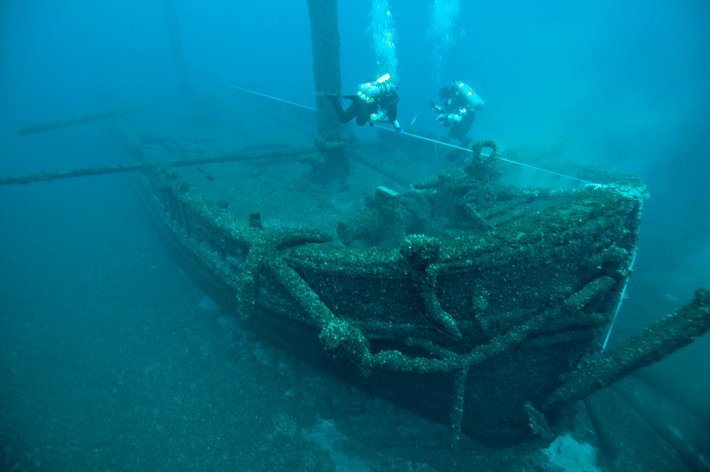
The Wrecks of Thunder Bay
|
Top 10 Discoveries of 2014
By THE EDITORS
Tuesday, December 16, 2014
 Ever since the discovery of the largest known Greek tomb was announced in August, archaeology buffs around the world have been eagerly awaiting each successive bit of news from the site. The Amphipolis tomb, which dates to the time of Alexander the Great, is a prime example of how archaeology can captivate the public imagination and easily earned a spot on our list of the Top 10 Discoveries of 2014.
Ever since the discovery of the largest known Greek tomb was announced in August, archaeology buffs around the world have been eagerly awaiting each successive bit of news from the site. The Amphipolis tomb, which dates to the time of Alexander the Great, is a prime example of how archaeology can captivate the public imagination and easily earned a spot on our list of the Top 10 Discoveries of 2014.
Equally impressive was the discovery, after decades upon decades of searching, of a ship that sank in Arctic waters in present-day Canada almost 170 years ago while looking for the Northwest Passage. That find was deemed so momentous that Canadian Prime Minister Stephen Harper took it upon himself to make the official announcement.
Archaeologists were also hard at work in the lab squeezing as much insight as possible out of limited evidence. Analysis of 6,000-year-old funerary wrappings established that ancient Egyptians practiced artificial mummification much earlier than had been thought. Genetic material from a skeleton found in an underwater cave in Mexico helped shed light on the relationship between the first people to arrive in the Americas and modern Native Americans. And a clever approach to interpreting the genome of Neanderthals revealed factors beyond the raw genetic code that explain how they differed from modern humans.
This year’s finds span the globe and tens of thousands of years, but are united in demonstrating archaeology’s ability to uncover hidden truths. What better example than the revelation via remote-sensing technologies that Stonehenge is surrounded by thousands of yet-to-be-interpreted Neolithic archaeological features? The discoveries on our top 10 list stand as a reminder that there is always more to learn about our past.
Advertisement
DEPARTMENTS
Also in this Issue:
Advertisement
IN THIS ISSUE
Trenches
The Price of Plunder
Off The Grid
A Tale of Two Railroads
On the Origins of Art
Fancy Footwear
The King is Dead. Long Live the King
Cults of the Bronze Age
Symbolic Neanderthals
Hollywood Exodus
Egypt's Disappearing Animals
Across the Atlantic by Flipper
Viking Treasure Trove
Paleo-escargot
Maya Cities Lost and Found
Advertisement

Recent Issues
-
 May/June 2024
May/June 2024
-
 March/April 2024
March/April 2024
-
 January/February 2024
January/February 2024
-
 November/December 2023
November/December 2023
-
 September/October 2023
September/October 2023
-
 July/August 2023
July/August 2023
-
 May/June 2023
May/June 2023
-
 March/April 2023
March/April 2023
-
 January/February 2023
January/February 2023
-
 November/December 2022
November/December 2022
-
 September/October 2022
September/October 2022
-
 July/August 2022
July/August 2022
-
 May/June 2022
May/June 2022
-
 March/April 2022
March/April 2022
-
 January/February 2022
January/February 2022
-
 November/December 2021
November/December 2021
-
 September/October 2021
September/October 2021
-
 July/August 2021
July/August 2021
-
 May/June 2021
May/June 2021
-
 March/April 2021
March/April 2021
-
 January/February 2021
January/February 2021
-
 November/December 2020
November/December 2020
-
 September/October 2020
September/October 2020
-
 July/August 2020
July/August 2020
-
 May/June 2020
May/June 2020
-
 March/April 2020
March/April 2020
-
 January/February 2020
January/February 2020
-
 November/December 2019
November/December 2019
-
 September/October 2019
September/October 2019
-
 July/August 2019
July/August 2019
-
 May/June 2019
May/June 2019
-
 March/April 2019
March/April 2019
-
 January/February 2019
January/February 2019
-
 November/December 2018
November/December 2018
-
 September/October 2018
September/October 2018
-
 July/August 2018
July/August 2018
-
 May/June 2018
May/June 2018
-
 March/April 2018
March/April 2018
-
 January/February 2018
January/February 2018
-
 November/December 2017
November/December 2017
-
 September/October 2017
September/October 2017
-
 July/August 2017
July/August 2017
-
 May/June 2017
May/June 2017
-
 March/April 2017
March/April 2017
-
 January/February 2017
January/February 2017
-
 November/December 2016
November/December 2016
-
 September/October 2016
September/October 2016
-
 July/August 2016
July/August 2016
-
 May/June 2016
May/June 2016
-
 March/April 2016
March/April 2016
-
 January/February 2016
January/February 2016
-
 November/December 2015
November/December 2015
-
 September/October 2015
September/October 2015
-
 July/August 2015
July/August 2015
-
 May/June 2015
May/June 2015
-
 March/April 2015
March/April 2015
-
 January/February 2015
January/February 2015
-
 November/December 2014
November/December 2014
-
 September/October 2014
September/October 2014
-
 July/August 2014
July/August 2014
-
 May/June 2014
May/June 2014
-
 March/April 2014
March/April 2014
-
 January/February 2014
January/February 2014
-
 November/December 2013
November/December 2013
-
 September/October 2013
September/October 2013
-
 July/August 2013
July/August 2013
-
 May/June 2013
May/June 2013
-
 March/April 2013
March/April 2013
-
 January/February 2013
January/February 2013
-
 November/December 2012
November/December 2012
-
 September/October 2012
September/October 2012
-
 July/August 2012
July/August 2012
-
 May/June 2012
May/June 2012
-
 March/April 2012
March/April 2012
-
 January/February 2012
January/February 2012
-
 November/December 2011
November/December 2011
-
 September/October 2011
September/October 2011
-
 July/August 2011
July/August 2011
-
 May/June 2011
May/June 2011
-
 March/April 2011
March/April 2011
-
 January/February 2011
January/February 2011
Advertisement






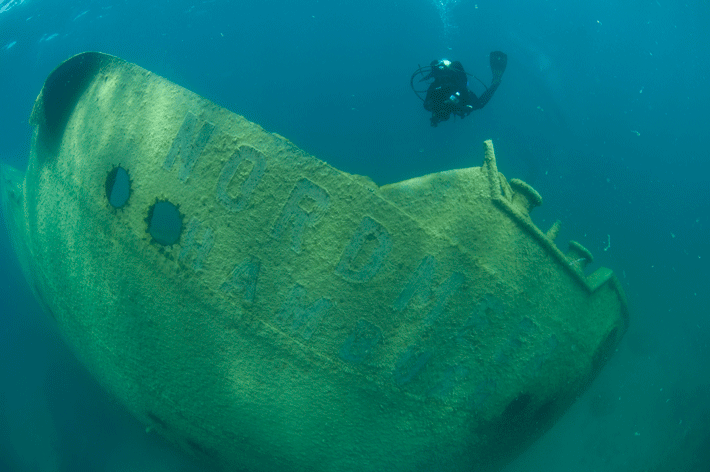 “It’s a little overwhelming when a boat is intact on the bottom,” says Wayne Lusardi, underwater archaeologist for the state of Michigan, which comanages the sanctuary. Away from surface waves, scouring ice, and recreational divers, the deepest wrecks stay in good condition. As he puts it, “They stay lost longer.” And many, many boats were lost in this part of Lake Huron.
“It’s a little overwhelming when a boat is intact on the bottom,” says Wayne Lusardi, underwater archaeologist for the state of Michigan, which comanages the sanctuary. Away from surface waves, scouring ice, and recreational divers, the deepest wrecks stay in good condition. As he puts it, “They stay lost longer.” And many, many boats were lost in this part of Lake Huron.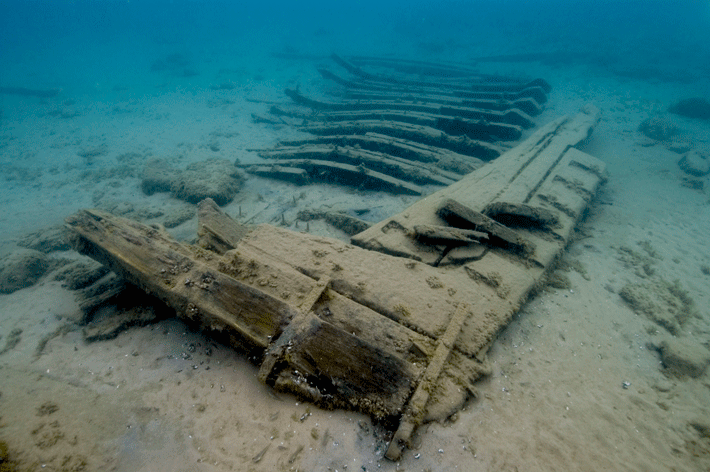
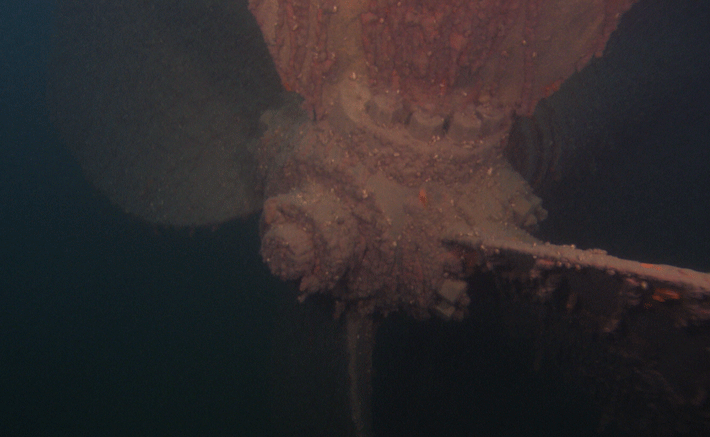 “It’s pretty amazing what lies beneath the lakes,” says Lusardi. “Most people have no idea how big the lakes are and how ferocious they can be and how they can just swallow things up.”
“It’s pretty amazing what lies beneath the lakes,” says Lusardi. “Most people have no idea how big the lakes are and how ferocious they can be and how they can just swallow things up.”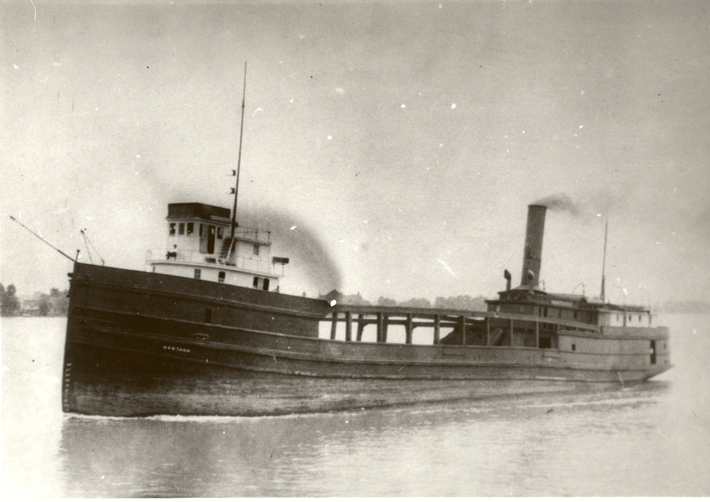
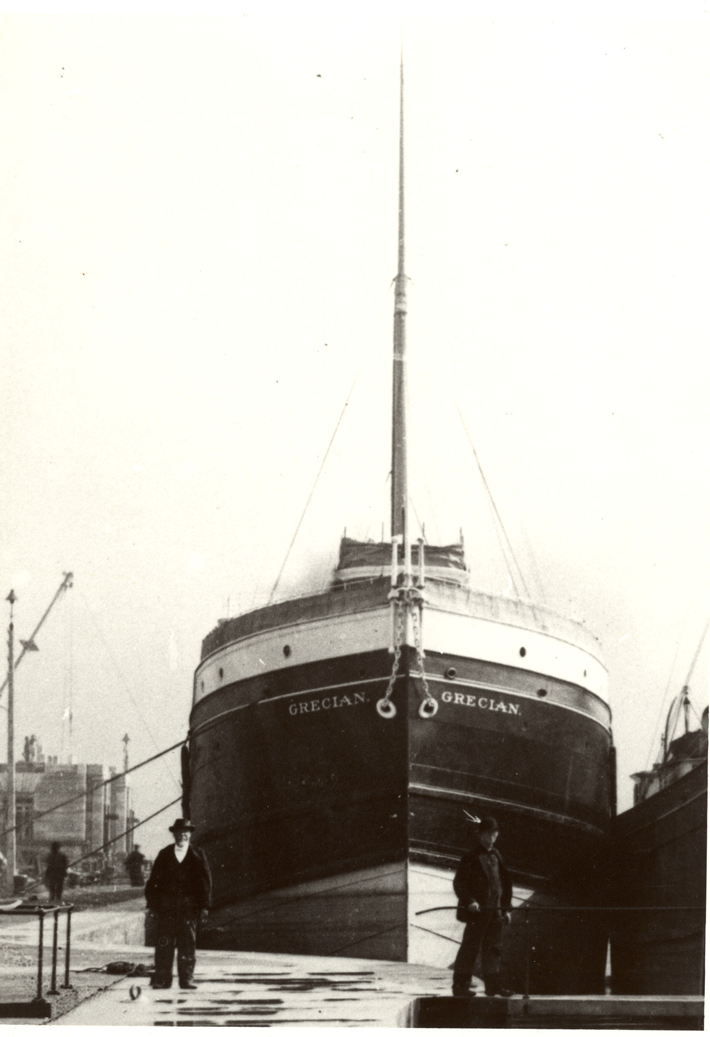 Though the wrecks remain well preserved, Lake Huron is a dynamic environment, and the last decade or so has seen sweeping ecological changes in the Great Lakes. The St. Lawrence Seaway, which connects the Great Lakes to the Atlantic via Montreal, opened in 1959 and provides lake access to deep-draft oceangoing vessels. These ships brought stowaways: In the late 1980s, zebra mussels, small aquatic invertebrates native to Russian lakes, were first spotted in the Great Lakes. They have since become an invasive species, encrusting hard surfaces and damaging lakeside infrastructure. By the 1990s, they had spread around the Great Lakes and American rivers, including at Thunder Bay. The mollusks are filter feeders, and for a little while they cleared up the water column and provided divers and archaeologists with great visibility. “That was really a magic moment for documenting deep-water wrecks,” says Green. But they also began to cling to the shipwrecks. Within a few years, the zebra mussels in Thunder Bay were outcompeted by another invasive species, the larger quagga mussel, native to Ukraine, that now seems to completely blanket the wrecks in the sanctuary. The seemingly positive effect on water visibility was short-lived. The clearer water they created allows sunlight to penetrate deeper, where it feeds algal growth, depending on the season. Some wrecks now sport shaggy beards of algae in the summer, further obscuring details and artifacts. Many of the wrecks the archaeologists have looked at recently were last examined and photographed in 2005, when mussels were present but not pervasive.
Though the wrecks remain well preserved, Lake Huron is a dynamic environment, and the last decade or so has seen sweeping ecological changes in the Great Lakes. The St. Lawrence Seaway, which connects the Great Lakes to the Atlantic via Montreal, opened in 1959 and provides lake access to deep-draft oceangoing vessels. These ships brought stowaways: In the late 1980s, zebra mussels, small aquatic invertebrates native to Russian lakes, were first spotted in the Great Lakes. They have since become an invasive species, encrusting hard surfaces and damaging lakeside infrastructure. By the 1990s, they had spread around the Great Lakes and American rivers, including at Thunder Bay. The mollusks are filter feeders, and for a little while they cleared up the water column and provided divers and archaeologists with great visibility. “That was really a magic moment for documenting deep-water wrecks,” says Green. But they also began to cling to the shipwrecks. Within a few years, the zebra mussels in Thunder Bay were outcompeted by another invasive species, the larger quagga mussel, native to Ukraine, that now seems to completely blanket the wrecks in the sanctuary. The seemingly positive effect on water visibility was short-lived. The clearer water they created allows sunlight to penetrate deeper, where it feeds algal growth, depending on the season. Some wrecks now sport shaggy beards of algae in the summer, further obscuring details and artifacts. Many of the wrecks the archaeologists have looked at recently were last examined and photographed in 2005, when mussels were present but not pervasive.
